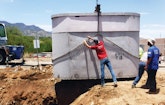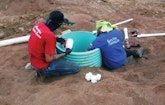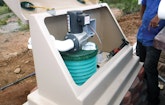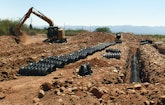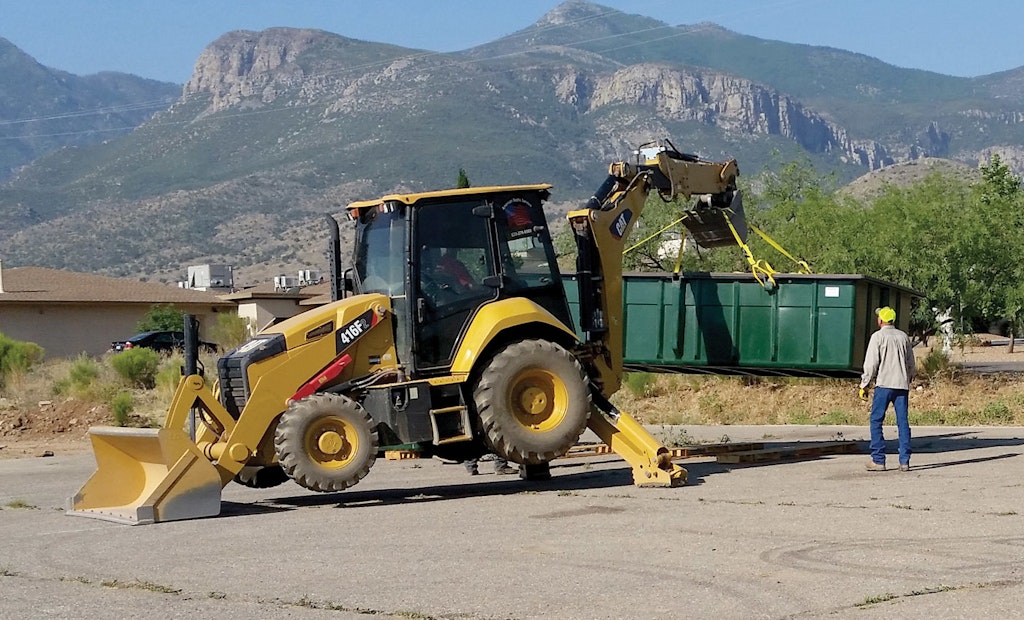
Foreman Zak Long of American Septic Service uses a Caterpillar 461F2 backhoe loader to unload a 2,000-pound AdvanTex AX100 module (Orenco Systems).
Transitioning a residential institution in Hereford, Arizona, to an assisted living facility required upgrading the onsite system.
The new owner hired Dawn Long, field coordinator and onsite designer for American Septic Service in nearby Sierra Vista, to inspect the system. She found a leaking 10,000-gallon homemade concrete block septic tank and, more than 300 feet from the three buildings, a 7,000-gallon septic tank with drainfield on a 332-by-188-foot-wide easement. “The easement ran through the middle of 10 acres and was barely visible,” Long says. “I saw very little room for expansion.”
Long worked with Peter Livingston, P.E., the engineer of record from Bosque Engineering in Atascadero, California, to comply with Arizona’s nitrogen density loading requirements. He recommended AdvanTex treatment modules from Orenco Systems. Pretreatment also reduced the drainfield’s footprint from 400 to 250 chambers, enabling the designers to fit it between the lower parking lot and existing absorption bed.
“This was our largest installation to date,” says Zak Long, foreman for American Septic Service. “Besides the breadth of the work for a small company, the monsoon season threatened to wash us out.” The project took two months.
Site conditions
Soils are sandy clay loam with 30 to 35 percent rock and a loading rate of 0.4 gpd per square foot. The 6.69-acre property has an upper and lower parking lot.
System components
Livingston and Dawn Long designed the system to handle 7,625 gpd. Major components are:
- Existing 1,000-gallon tri-compartment precast grease interceptor
- Existing 4,000-gallon single-compartment precast septic tank
- 4,000-gallon and 2,000-gallon single-compartment oval concrete septic tanks in series (Padilla Precast)
- EF-6 effluent filter in the second tank and four 24-inch risers with heavy-duty lids (TUF-TITE)
- Existing 7,000-gallon single-compartment precast dose/recirculation tank with two Biotube pump vaults (Orenco Systems)
- Two AdvanTex AX100 textile treatment modules (Orenco Systems)
- Four five-hole distribution boxes (TUF-TITE)
- 204 existing 6-foot-long high-capacity chambers in Zone 1 (Infiltrator Water Technologies)
- 250 4-foot-long Quick4 high-capacity chambers in Zone 2 (Infiltrator Water Technologies)
- TCOM remote telemetry control panel (Orenco Systems)
System operation
Liquid from the kitchen grease interceptor discharges 100 feet through a 4-inch line to the dose/recirculation tank. Wastewater from the first two buildings flows through a 6-inch pipe to the septic tanks, then through the 4-inch mainline 250 feet down a hill to the D/R tank. Wastewater from the third building flows through a 4-inch pipe to the existing 4,000-gallon tank, then to the D/R tank. All piping is Schedule 40 PVC.
Each on-demand 3/4 hp pump in the D/R tank sends 1,000 gallons at 50 gpm to a dedicated treatment module. The aboveground units sit higher than the tank and parallel to it. A gravity-flow collections system at the bottom of the modules returns polished water through a 4-inch pipe to the D/R tank.
From the tank, water gravity flows 18 inches through a 4-inch pipe to a manifold enclosed in a 24-inch riser. Two 4-inch lines send 2,940 gpd to Zone 1, and three lines send 4,685 gpd to Zone 2. Spaced 60 feet apart, both zones have 100-foot-long trenches. Zone 1 has 12 trenches of 17 chambers, and Zone 2 has 10 trenches of 25 chambers.
Drainfield installation
The first week, Zak Long, Alex Mills, his helper and Jared Struse, owner of Sierra Vista Plumbing, laid out the drainfield and distribution boxes, then Long used a rented Caterpillar 315FL excavator to dig the trenches for delivery lines, recirculation lines and manifold connections. They bedded all piping and system components on compacted pea gravel.
Rocks and tight setbacks made excavating difficult. “The field was 5 feet from a property line, and the trench for the 6-inch line and first distribution box were 12 inches from the southeast corner of the lower parking lot,” Long says.
As Long dug the 3-by-4.5-foot-deep trenches 10 feet on center, he checked their elevations with a GRL 250 HV self-leveling rotary laser (Robert Bosch Tool). Mills installed the chambers and an inspection port at the end of each trench.
Long also operated a rented Caterpillar 924 wheel loader to sift excavated material through a Grizzly rock screen separator to produce topsoil. He needed 6 to 12 inches to cover the trenches, then backfilled them to grade with native soil. The work took a week. Minutes after they finished, a downpour drenched the area.
Tank installation
o ensure the facility’s uninterrupted sanitary service for a week, Struse bypassed the homemade tank. Long exposed the 6-inch line from the buildings and dug a hole for a 100-gallon sewage basin with 1/2 hp grinder pump (Zoeller). Struse severed the pipe, allowing wastewater to drain into the basin. From the basin, he ran a 2-inch line 75 feet through the upper parking lot and spliced it into the 4-inch mainline.
“We joined the bypass sections with rubber couplings, enabling us to lift or move the line whenever machinery and traffic came or went,” Struse says. “The motion loosened the couplings and rocks fell on the pipe each time a load of spoil material left. We repaired the line a lot.”
Long then exposed the homemade septic tank, enabling Tom Van Wart, owner of A-1 Pumping, to clean it. Decommissioning the tank produced 144 tons of spoil that Joshua Flores, owner of J&D Roll Off and Hauling, disposed of in 12 trips over two days.
Flores then trucked in 176 tons of pea gravel, 47 tons of aggregate base course, 178 tons of clean fill and 20 tons of decorative rock at 12 tons per trip. He stockpiled the material on the lower, unused parking lot.
Meanwhile, Struse’s sons, Jesse and Jake, filled 100 sandbags to secure the safety fencing around the site and delay monsoon runoff from reaching the excavation. “HOOK Crane Service in Tucson planned to set the 4,000-gallon tank on Friday, but a large storm was predicted that morning,” Long says. “It had the potential to destroy our hole.”
He rescheduled the delivery for Thursday, but the tank arrived without the inlet penetration. Minutes after setting the tank, rain fell in torrents for five hours. While Struse and Long drilled the 6-inch inlet and connected the delivery line, Mills returned to the shop for 30 feet of 4-inch pipe and couplings. With them, Struse temporarily connected the tank to the mainline, eliminating the bypass system.
After setting the second septic tank on Monday, Struse plumbed them both to the mainline. Long backfilled the tanks one-quarter of the way up with pea gravel followed by ABC to cover and topsoil to grade. The second and third layers were soaked with a hose and settled by frequent rains.
Easiest phase
Installing the treatment modules was straightforward. Long built a pea gravel pad and set them on it. “The only thing different was enlarging the two holes in the D/R tank lid for the Orenco Systems risers with recirculating valves and Biotubes,” he says. The tank was directly below the pad.
To avoid damaging the maze of piping, Mills and Dawn Long shoveled sand over the lines. Zak Long then added topsoil, bringing the total depth to 3.5 feet. Although the area is secluded, Dawn Long ordered five boulders placed around the pad to protect the modules from collisions.
Before leaving, Struse jetted the existing distribution boxes using a trailer-mounted 55VL hydro vacuum cleaner (Ring-O-Matic). “Only metal plates covered the boxes, and everything from bees to kangaroo rats had nested in them,” Struse says. He also jetted the 6-inch line to ensure no debris remained from the grinder pump.
Maintenance
American Septic Service holds the maintenance contract.

